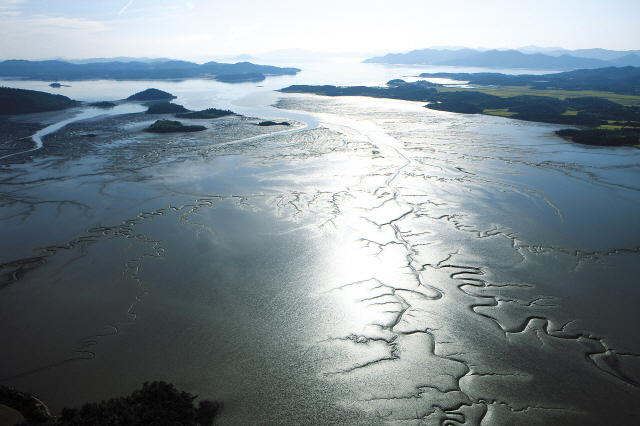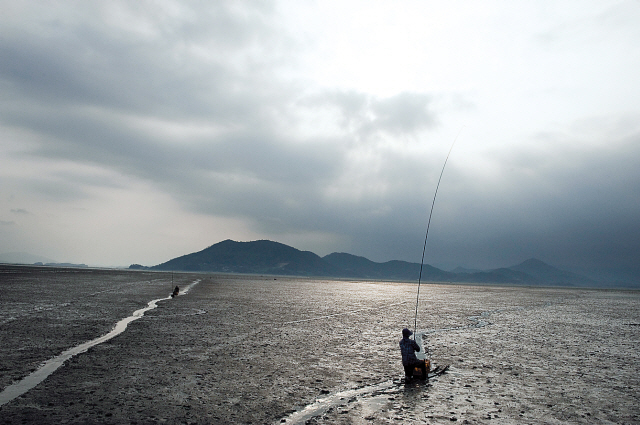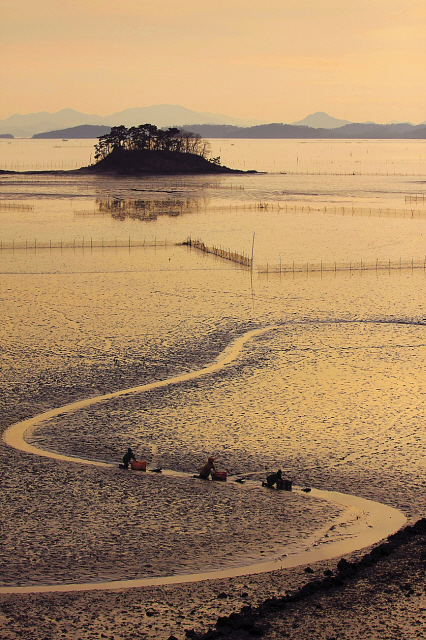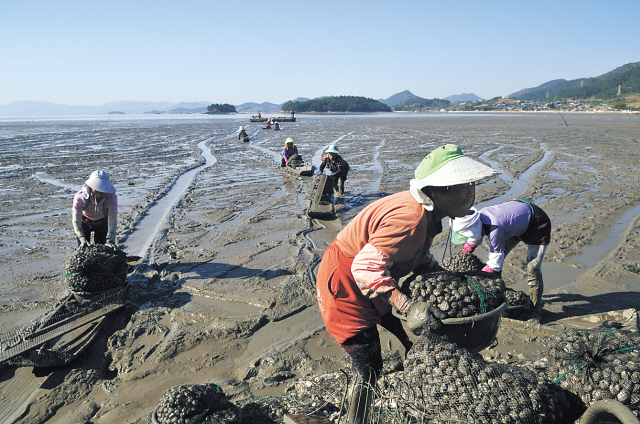Life-giving land: Tidal flats are haven for marine creatures
2013-02-20 20:41
 |
| The tidal flats in Boseong Bay (Korea Tourism Organization) |
Mullet from the mudflats of Muan is a local delicacy that was offered at the king’s table during the Joseon period (1392-1910).
The Muan tidal flat, home to the mullet and other marine life, is the first tidal flat registered as a national park in Korea as well as being on the Ramsar Wetlands list.
Extensive mudflats stretch out from the southwestern coast of the Korean Peninsula, accounting for 83 percent of Korea’s mudflats, with a total area of more than 1,000 square kilometers.
The Jeolla region hosts the southwest coast mudflats that run from Buan and Gochang in the northern area of the province to Muan, Sinan, Boseong and Suncheon in the southern province.
They are natural habitats for a variety of marine creatures, sea plants, water birds and migratory birds.
As a result of years of efforts to preserve the area, the mudflats have been designated as a wetland conservation area by the Korean government. The Sinan mudflats are also registered as Ramsar Wetlands and on the tentative list of UNESCO World Heritage Sites.
The southwestern tidal flats have been compared to the extensive tidal flats on the Wadden Sea along the coasts of the Netherlands, Germany and Denmark, which were inscribed as a World Heritage Site in 2009.
“It certainly has distinctive features in terms of natural beauty and geomorphic and physiographic features from the Wadden Sea,” said Moon Kyung-o, visiting professor of Mokpo National University and emeritus tenure professor of Krasnoyarsk State Pedagogical University in Russia, who has been participating as a senior researcher in the preparatory work for designation of the southwestern flats on the World Heritage list.
Open-air museum
The southwestern tidal flats have developed a unique landscape, exhibiting different stages of tidal flats from mudflats to mixed flats and sand flats.
With different stages of tidal flats shown all at once, the southwestern tidal flats are a living museum.
The creation of the tidal flats dates back to the Cretaceous Period when ash and sediment from volcanic eruptions accumulated in one place. The tidal flat we see now started to take shape about 7,000 years ago as the Yellow Sea began to level out, ending the rapid rise of the sea level that started 20,000 years ago.
The preservation of layers of sediment is in good condition, according to the on-site evaluation of Suncheon Bay by the Korean preparatory committee working for its designation as a UNESCO World Heritage site.
 |
| The tidal flats in Suncheon Bay (Korea Tourism Organization) |
Since the tidal flats were designated as a protected area, their natural life cycle is recovering, creating a large diversity of marine life alongside a unique, traditional way of life for the local residents. Sand, mud beaches and saltwater plants form a scenic landscape, making the tidal flats picturesque locations for photographers.
Saltwater plants add to the beauty to the landscape of the flats. Some of the rare salt-tolerant plants in this region include suaeda japonica makino, whose leaves change color seven times a year, and angelica utilis makino, considered a rare species of high value in Japan and China.
Unlike the Wadden Sea, no barrier land is developed on the Korean western shore, making the tidal flats widely spread.
The appearance of the tidal flats changes throughout the four seasons. During the summer, fine mud builds up, but it erodes in the winter, turning into sand flats.
Further research is under way into the unique geographical and ecological features of the southwestern mudflats.
“Unlike cultural heritage sites, which clearly show their unique values, natural sites need scientific data that can prove they are one-of-a-kind places in the world,” said Moon.
While Korea has 10 cultural and natural heritage sites registered with UNESCO, the Jeju Volcanic Island and Lava Tubes is the only natural site designated by the international agency.
Moon expects it will take some time to gather information about the tidal flats and create credible data that can win it a “comparative advantage” over other nominated sites.
“It took 20 years for the Wadden Sea to prepare for the designation. We are in the initial stage of research and need to conduct thorough research to compile data that can persuade the world that the site needs to be protected together,” said Moon.
Life built on tidal flats
“What’s special about the southwestern tidal flats is that there is tradition and way of life that has been built on tidal flats for hundreds of years,” said Moon.
According to Moon, the southwestern tidal flats have a unique fishing culture and tradition that may meet UNESCO’s requirements for a mixed heritage site.
Tidal flats are a fragile habitat for marine life that needs constant care. The villagers living in the tidal flats heed nature’s rule.
The inhabitants of Yongsan Village of Muan County, once divided between reclamation and conservation, have now set rules to preserve the tidal flats together. They set the day and hours to be spent on the mud and try not to encroach on it unnecessarily. Instead, they make a narrow route to cross the mudflats when picking shellfish or catching fish.
 |
| Sunset at the tidal flats of Waon Village in Suncheon Bay (Korea Tourism Organization) |
 |
| Villagers harvest cockles on the tidal flats in Suncheon Bay (Korea Tourism Organization) |
The different-colored spots on the tidal flats reveal their wildlife diversity. Sand crabs, cockles and small octopuses are key resources that help residents make a living.
The villagers also stick to traditional fishing methods and continue their traditional ways of life.
They pick cockles and catch small octopuses by hand and use a wooden board to help them move around the mudflat.
Villagers living along Suncheon Bay decide the time to fish based on tide cycle. The waters hit low tide twice a day: once each at night and in the daylight.
When the water reaches low tide, they head out to the field, harvest fresh clams and catch fish and mudskippers, regarded a delicacy of Suncheon.
By Lee Woo-young (wylee@heraldcorp.com)


